Silicon Detectors
The silicon detectors that can be simulated comes in two forms, a single strip detector (--sistrip, --dsssd), and a SIlicon Array (SIA) which comes with two flavours, --isia and --hsia. The flavours are detector objects with parameters set to correspond to the Si array used in Helios (hsia) and in ISS (isia). The two objects have the same parameters but with different default values. This makes it easier to simulate either one without the need to add a lot of parameter changes on the command line. But let us first cover a single silicon strip.Table of contents
Position Sensitive Silicon Strip
The silicon strip consists of a single active layer of silicon with its orientation as depicted in the figure below. The active part of the detector is in gray and is surrounded by an inactive layer (blue). It can be used to simulate a luminosity detector, or as a part of a silicon array. It has a digitizer with a resistive readout at each end and a readout at the back.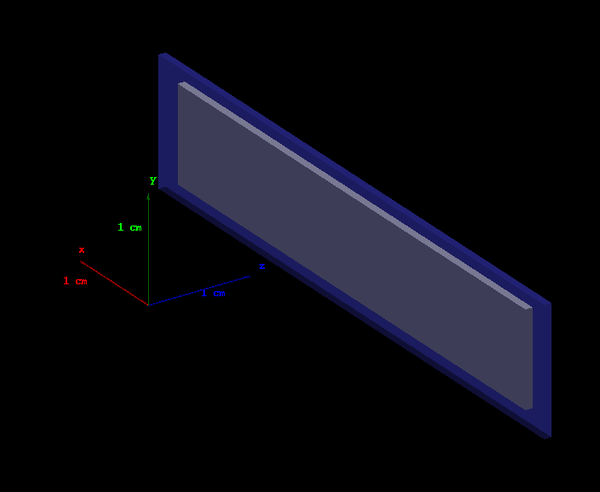
Help text in ggland
To get updated information on the detector and its parameters, type --sistrip=help to get the following output:
Parse: sistrip
Si detector strip (resistive readout 1 dim). This single-strip detector is used to detect protons in HELIOS. The strip uses a digitizer which gives energies in both ends of the strip with resistive readout, as well as the full energy at the back side of the detector. Default dimensions correspond to those in HELIOS.
rot{x,y,z}|x0|y0|z0 0 1|cm Rotation | Location. (Cumulative.)
dx 5.05 cm Active length of the strip.
dy 0.9 cm Active width of the strip.
dz 0.07 cm Full thickness of the strip.
deadlayer 2e-05 cm Thickness of deadlayer.
inactive_x 0.275 cm Inactive material x direction.
inactive_y 0.15 cm Inactive material y direction.
type Si Detector material.
enter 0 Include incoming particles in tree.
sigma_x 0.02 cm x blurring in tree output.
sigma_y 0.02 cm y blurring in tree output.
sigma_z 0.02 cm z blurring in tree output.
sigma_t 3 ns t blurring in tree output.
sigma_e 0.01 e blurring in tree output.
noblur Do not randomise clusterized
x,y,z,t,e output.
spec=DET-ABC With specification of DET-ABC,
location not taken, given explicitly.
inside=DET-ABC Inside root volume of DET-ABC.
tree-sort-by-t Sort clusters by time instead of decreasing energy.
tree-num-clusters=N Number of clusters to include (default 10).
tree-max-cluster=N Maximum length of a cluster (default 10 cm).
tree-cluster-coord=[world|det|seg] Cluster coordinate (default det).
tree-keep-cluster-prob=[I=]P Prob. to keep cluster (per subvolume I).
tree-keep-event-prob=[I=]P Prob. to keep all clusters (per subvolume I).
tree-gun-edep Record total deposited energy for each primary.
tree-name=NAME Override default name.
These are the parameters that can be changed, with their default values and a short description of each parameter. Always refer to the ggland output for an updated description, not the copy above.
Using the Silicon strip
Let us consider a simple script using the --sistrip:
./land_geant4 --sistrip=z0=2cm\
--gun=p,T=2MeV,isotropic \
--world=type=vacuum --events=50000 \
--tree=digi,test.root
Resistive readout or wafer
The sistrip has a resistive readout, meaning that the digitizer takes each hit on the detector and propagates it to the sides of the detector. There is another type where the strip is segmented horizontally on the one side, and vertically on the other side. To simulate these detectors with a "pixelated" output, you can use the dsssd version below.
Double Sided Silicon Strip Detector
Similar to the sistrip, this detector consists of one active layer of silicon (gray), surrounded by an inactive part (blue), as shown in the figure below. The DSSSD has a two-channel output; one for hits on the x segments and one for the hits on the y segments. Its default parameter values correspond to the DSSSDs in the ISS silicon array.
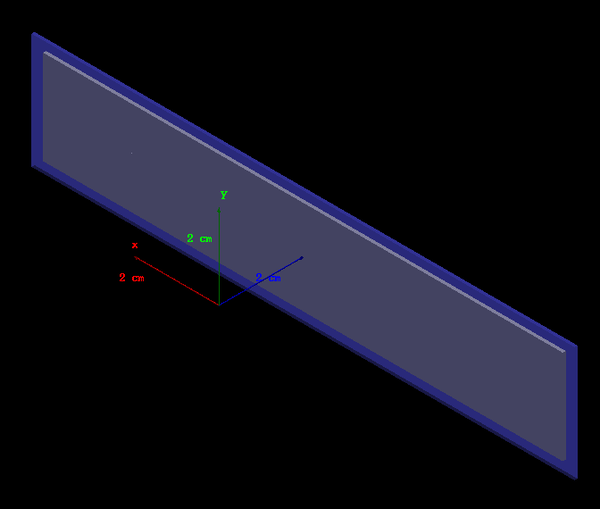
Help text in ggland
To get updated information on the detector and its parameters, type --dsssd=help to get the following output:
Parse: dsssd
Double Sided Silicon Strip Detector. These type of detector is, among others, used to detect protons in ISS. The strips have orthogonal outputs, one for hits on the x segments and one for the y segments.Default design correspond to the strips in ISS.
rot{x,y,z}|x0|y0|z0 0 1|cm Rotation | Location. (Cumulative.)
dx 12.16 cm Active length.
dy 2.2 cm Active width.
dz 0.07 cm Full thickness.
deadlayer 2e-05 cm Thickness of deadlayer.
inactive_x 0.275 cm Inactive material x direction.
inactive_y 0.25 cm Inactive material y direction.
strips_x 128 Number of segments along the x-axis.
strips_y 11 Number of segments along the y-axis.
type Si Detector material.
enter 0 Include incoming particles in tree.
sigma_x 0.02 cm x blurring in tree output.
sigma_y 0.02 cm y blurring in tree output.
sigma_z 0.02 cm z blurring in tree output.
sigma_t 3 ns t blurring in tree output.
sigma_e 0.01 e blurring in tree output.
noblur Do not randomise clusterized
x,y,z,t,e output.
spec=DET-ABC With specification of DET-ABC,
location not taken, given explicitly.
inside=DET-ABC Inside root volume of DET-ABC.
tree-sort-by-t Sort clusters by time instead of decreasing energy.
tree-num-clusters=N Number of clusters to include (default 10).
tree-max-cluster=N Maximum length of a cluster (default 10 cm).
tree-cluster-coord=[world|det|seg] Cluster coordinate (default det).
tree-keep-cluster-prob=[I=]P Prob. to keep cluster (per subvolume I).
tree-keep-event-prob=[I=]P Prob. to keep all clusters (per subvolume I).
tree-gun-edep Record total deposited energy for each primary.
tree-name=NAME Override default name.
Using the DSSSD
A simple script with the DSSSD:
./land_geant4 --dsssd=z0=2cm\
--gun=p,T=2MeV,isotropic \
--world=type=vacuum --events=50000 \
--tree=digi,test.root
You can then open the root file in ROOT and plot h102→Draw("DSSSDuy:DSSSDux") and get something similar to the plot below. A quick note is that the two channels, DSSSDu and DSSSDv, are separate channels. They are also orthogonal to each other so they should not be plotted against each other without any preprocessing first. Take a look at the CD detector for more information.
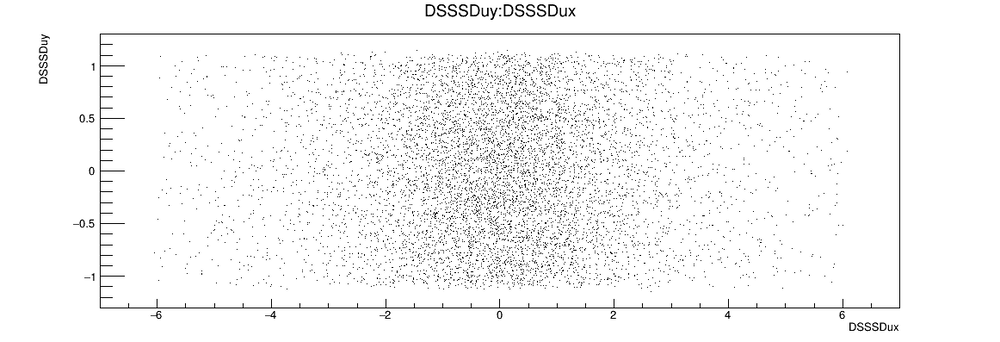
(HELIOS) Silicon Array
If we want to look at back scattering protons a detector array of silicon strips can be used. In ggland, a highly modifiable array exists called Helios SIlicon Array (HSIA) with default parameters corresponding to the silicon array used at ANL. It consists of 24 silicon strips, distributed on four sides (six strips per side), as the image shows. The white parts are the silicon strips mounted on a hollow aluminium base (gray). The strips' indices are numbered; starting with 0 at the far back (z-direction) of the array counting clockwise (?) each side before going forward (z-direction). This will be double checked and updated! Some revision of the code will be done, but should not affect the user apart from the indexing (possibly). In other words, if you use either the --hsia or the --isia version no changes should be necessary when the code is updated. Scripts processing the output tree might need an update though.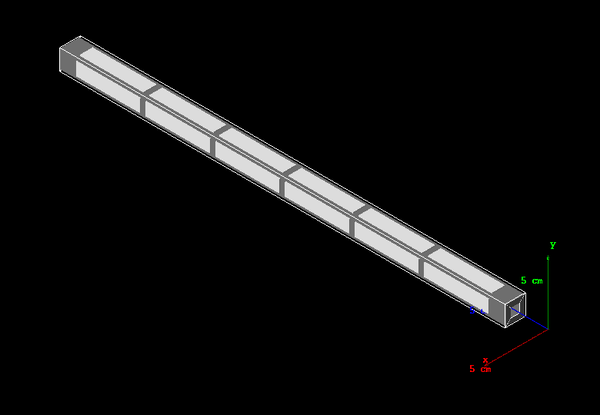
Help text in ggland
First, let us take a look at the help text from ggland by using --hsia=help:
Parse: hsia
rot{x,y,z}|x0|y0|z0 0 1|cm Rotation | Location. (Cumulative.)
si_thick 0.08 cm Full thickness of active volumes.
si_width 1 cm Full width active volumes.
si_length 5 cm Full length of active volumes.
pad 0.45 cm Padding of detectors.
n 6 Number of detectors per side.
nphi 4 Number of sides, shape of array.
dz_casing_pad 1.29 cm Lengthen casing in +/- z-direction.
type Si Active material.
ctype Al Casing material.
enter 0 Include incoming particles in tree.
sigma_x 0.02 cm x blurring in tree output.
sigma_y 0.02 cm y blurring in tree output.
sigma_z 0.02 cm z blurring in tree output.
sigma_e 0.01 e blurring in tree output.
sigma_t 3 ns t blurring in tree output.
noblur Do not randomise clusterized
x,y,z,t,e output.
spec=DET-ABC With specification of DET-ABC,
location not taken, given explicitly.
inside=DET-ABC Inside root volume of DET-ABC.
tree-sort-by-t Sort clusters by time instead of decreasing energy.
tree-num-clusters=N Number of clusters to include (default 10).
tree-max-cluster=N Maximum length of a cluster (default 10 cm).
tree-cluster-coord=[world|det|seg] Cluster coordinate (default det).
tree-keep-cluster-prob=[I=]P Prob. to keep cluster (per subvolume I).
tree-keep-event-prob=[I=]P Prob. to keep all clusters (per subvolume I).
tree-gun-edep Record total deposited energy for each primary.
tree-name=NAME Override default name.
Using hsia
Let us consider a basic example of back scattering protons in a magnetic field of 2 tesla:
./land_geant4 --hsia=z0=-20cm\
--gun=p,T=2MeV,isotropic \
--world=type=vacuum --events=50000 \
--fieldbox=d=60cm,Bz=-2T \
--tree=digi,test.root
This will place the silicon array's origin (mid, center point) 20 cm behind the target to allow detection of protons traveling in the backward direction (-z). The digi option has to be set for --tree in order for the digitizer output to be stored in the ROOT tree. In root we can plot the two endpoints for the detectors by h102→Draw("HSIAde1:HSIAde2"). The following plot shows the result, the maximum energy readout is 2 MeV with some hits depositing less than 2 MeV.
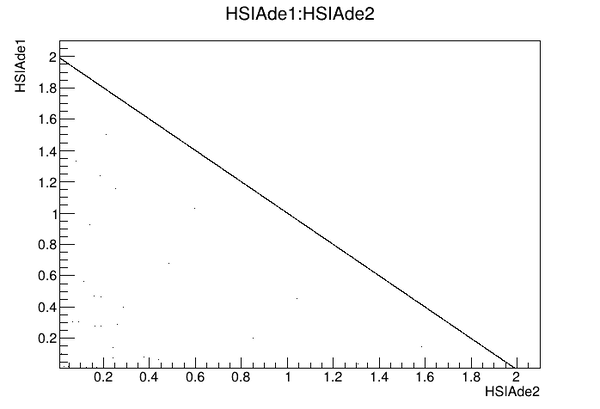
Note that the draw command will plot the readouts from all strips at once; to get the events from a single strip a condition ("HSIAdi==2" for example) has to be added in order to get the (third) strip's events.
ISS Version
There is an ISS version of the silicon array called --isia which is a version of the --hsia with parameters corresponding to those in ISS. At the moment, isia does not have DSSSD's but resistive silicon strips. This will be changed as soon as ggland gets an update to allow for detectors to inherit other detectors properties.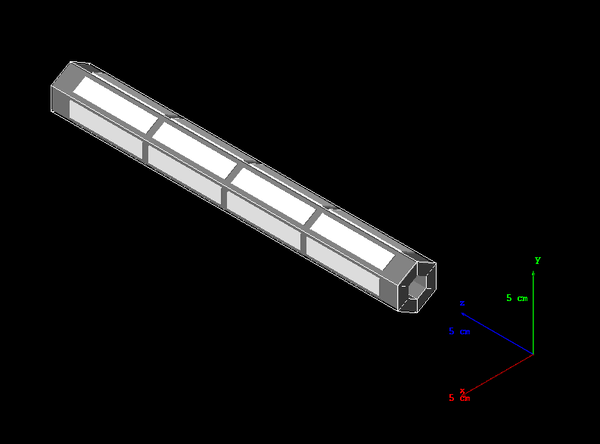
Help text in ggland
Parse: isia
rot{x,y,z}|x0|y0|z0 0 1|cm Rotation | Location. (Cumulative.)
si_thick 0.08 cm Full thickness of active volumes.
si_width 1 cm Full width active volumes.
si_length 5 cm Full length of active volumes.
pad 0.45 cm Padding of detectors.
n 4 Number of detectors per side.
nphi 6 Number of sides, shape of array.
dz_casing_pad 1.29 cm Lengthen casing in +/- z-direction.
type Si Active material.
ctype Al Casing material.
enter 0 Include incoming particles in tree.
sigma_x 0.02 cm x blurring in tree output.
sigma_y 0.02 cm y blurring in tree output.
sigma_z 0.02 cm z blurring in tree output.
sigma_e 0.01 e blurring in tree output.
sigma_t 3 ns t blurring in tree output.
noblur Do not randomise clusterized
x,y,z,t,e output.
spec=DET-ABC With specification of DET-ABC,
location not taken, given explicitly.
inside=DET-ABC Inside root volume of DET-ABC.
tree-sort-by-t Sort clusters by time instead of decreasing energy.
tree-num-clusters=N Number of clusters to include (default 10).
tree-max-cluster=N Maximum length of a cluster (default 10 cm).
tree-cluster-coord=[world|det|seg] Cluster coordinate (default det).
tree-keep-cluster-prob=[I=]P Prob. to keep cluster (per subvolume I).
tree-keep-event-prob=[I=]P Prob. to keep all clusters (per subvolume I).
tree-gun-edep Record total deposited energy for each primary.
tree-name=NAME Override default name.
Script with isia
A simple script with isia:
./land_geant4 --isia=z0=-20cm\
--gun=p,T=2MeV,isotropic \
--world=type=vacuum --events=50000 \
--fieldbox=d=60cm,Bz=-2T \
--tree=digi,test.root
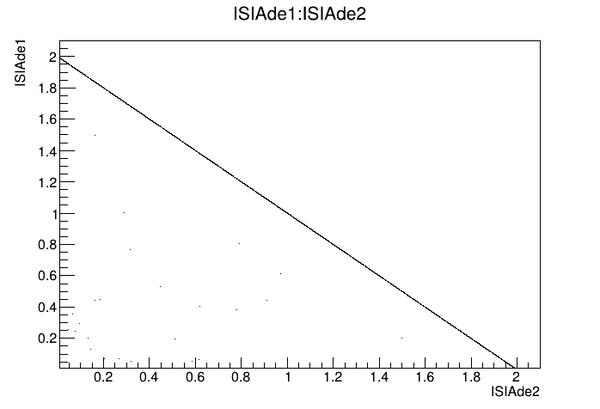
 Copyright © by the contributing authors. All material on this collaboration platform is the property of the contributing authors.
Copyright © by the contributing authors. All material on this collaboration platform is the property of the contributing authors. Ideas, requests, problems regarding Foswiki? Send feedback
